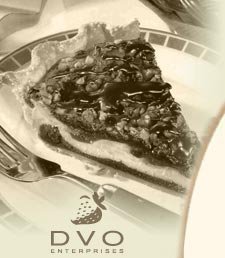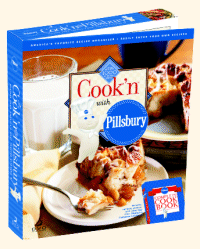
|
Never miss another recipe... Sign up for our free monthly newsletter today!
Subscribing will not result in more spam! I guarantee it! NEWSLETTER
• Current Issue• Newsletter Archive • Sign Up Now 
Cook'n with Betty Crocker 
Cook'n with Pillsbury 
Cook'n with a Taste of Home 
Cook'n in Italy 
Cook'n in Mexico |
 |
Test Your Health IQ |
|
Print this Recipe 1) Which of the following breakfast items is lowest in fat? a. 1 cup granola with 1/2 cup fat-free (skim) milk b. 1 cup puffed cereal with 1/2 cup whole milk c. 1 bagel with 1 tablespoon jam or jelly d. 1 plain cake doughnut ANSWER: c. A 3-inch plain bagel weighs in at about 155 calories and has only 1 gram of fat. Top it with jam or jelly, and you add about 50 calories, but the fat stays the same. Your second best breakfast choice is the puffed cereal and milk with 130 calories and 4 grams of fat. Choose fat-free milk instead of whole milk, and you’ll cut out the fat entirely. However grab the granola, and you end up with a 470 calorie breakfast with 16 grams of fat. That even tops the doughnut with 170 calories and 10 grams of fat! 2) Oil labeled “light” contains less fat and calories than regular oil? True or false? ANSWER: False. All oils are 100 percent fat. One tablespoon of oil contains about 120 calories and nearly 14 grams of fat. When you see “light” on the label it refers to the color, not the fat or calorie content. 3) Calories don’t count as long as a food is low in fat. True or false? ANSWER: False. Calories do count. Calories are calories, whether they come from chocolate fudge cake or fat-free chocolate cookies. Too many calories can lead to weight gain. Excessive weight gain can in turn lead to obesity, another risk factor for heart disease. 4) Ounce for ounce, which has more cholesterol, prime rib or a chicken breast? ANSWER: They are nearly the same. Both contain approximately 85 milligrams of cholesterol. Where they differ substantially is in their fat content. A 3-ounce portion of prime rib contains over 30 grams of fat, and a 3-ounce portion of chicken breast with skin contains 8 grams of fat. Take the skin off, and the fat content dips to 3 grams and cholesterol drops to 75 milligrams. 5) Which of the following is the best source of antioxidants? a. Nuts b. Green tea c. Orange juice d. Sweet potatoes ANSWER: b. Whether you prefer it ice cold or steaming hot, green tea is an antioxidant powerhouse. New research shows that gree tea contains a powerful antioxidant, one some scientists believe is 100 times more potent than vitamin C and 25 times more effective than vitamin E. Antioxidants may help reduce the risk for heart disease and some cancers by protecting the cells in your body from damage. 6) All fat-free and low-fat foods are low in calories. True or false? ANSWER: False. Even though fat may be removed from a food, this does not mean that the calories are reduced. When fat is taken out, manufacturers often add other calorie containing components, such as sugars, to improve taste and texture. If you’re watching fat and calories, it’s best to compare nutrition labels between the fat-reduced product and the regular version. 7) If butter doesn’t appear on the ingredient list, the product is probably low in saturated fat. True or false? ANSWER: False. Saturated fat can be listed several ways. Cocoa butter, palm kernel oil, lard and shortening are just some of the many guises of this cholesterol-raising fat. 8) Regular exercise may help lower your risk for heart disease. True or false? ANSWER: True. Not only does regular exercise help you achieve or maintain a healthy body weight, it can also increase HDL (the “good” cholesterol) levels. Even better news is that you don’t have to follow the “no pain, no gain” philosophy of physical activity. Recent research indicates that moderate exercise, such as walking, biking and even housekeeping, can positively affect your health. From "Betty Crocker's Low-Fat, Low-Cholesterol Cooking Today." Text Copyright 2005 General Mills, Inc. Used with permission of the publisher, Wiley Publishing, Inc. All Rights Reserved. This recipe comes from the Cook'n collection. Try Cook'n for FREE! Here’s to your health Fat Facts Understanding Cholesterol Other Important Nutrients Putting It All Together Reading a Nutrition Label Go Slow For Success Test Your Health IQ The Skinny on Fat Cholesterol Trimming Tips Nutritional Comparison |
|
|
Affiliate Program | Privacy Policy | Other Resources | Contact Us
© 2008 DVO Enterprises, Inc. All rights reserved. Sales: 1-888-462-6656 |

